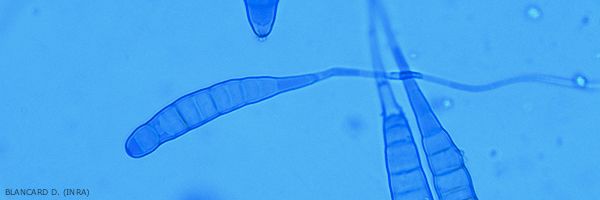
Alternaria linariae (Neerg.) E.G. Simmons
Alternate
- classification : Fungi, Ascomycota, Pezizomycotina, Dothideomycetes, Pleosporomycetidae, Pleosporales, Pleosporaceae
- teleomorph: Lewia
- species including the previous names Alternaria tomatophila , Alternaria solani
- English name: early blight
Among the aerial diseases of tomatoes, alternaria is certainly one of the most frequent and widespread in the world: it is found on all continents, wherever this nightshade is cultivated. It is found in many climates, in tropical, subtropical and temperate production areas. The presence of dews in semi-arid regions allows its development. It mainly affects field crops, and sometimes cold shelters. It is also very present in many amateur gardens. Its damage can be substantial if humid climatic conditions persist and / or if no protection method is considered. It sometimes causes significant defoliations causing a reduction in yields, but also numerous lesions on fruits linked to the effects of the sun on them, which are less protected by the foliage.
It is a disease very present in France ; it affects all field productions. It is sometimes found under plastic tunnels, hardly ever in intensive cultivation in heated glass greenhouses.
A. solani , reported for several decades on nightshades, has long been described as affecting tomato, eggplant, potato, as well as several weeds of this botanical family.
In fact, the situation of Alternaria spp. on these plants is much more complex. Thus, several species of Alternaria would be subservient to more than sixty Solanaceae. In addition, the appellation “ A. solani ” should be reconsidered, at least on tomato . Indeed, it appears that this plant is more likely to be found in another species, morphologically quite comparable to A. solani , called “ Alternaria tomatophila ”. In addition, two phenotypes would exist within this species, differentiable by the appearance of their colonies in Petri dishes : a clear phenotype, more aggressive on tomato, and a dark one.
A. solani believed to is be the pathogen of early blight of potato , and A. beringelae EG Simmons (2000) is believed to be found in eggplant .
It should be noted that A. subcylindrica EG Simmons & RG Roberts (2000) and A. cretica EG Simmons & Vakal., (2000) were occasionally observed on cherry tomato leaves for the first, and in Greece on lesions classic alternaria leaves for the second. Note that A. subtropica EG Simmons (2000) can cause fruit spots.
Other Alternaria also attack tomatoes , we will mainly evoke A. alternata f. sp. lycopersici , A. alternata and A. tomato (Cooke) Jones





